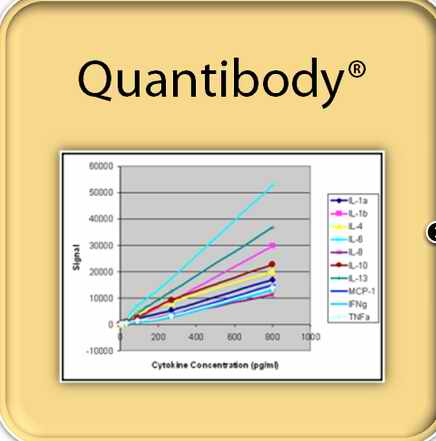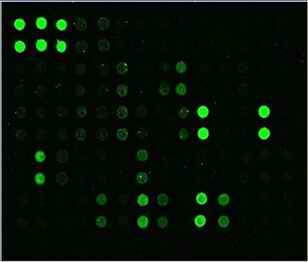
Human Angiogenesis Array Q3
Update:2014/7/20 21:03:45 View:2878
- Type QAH-ANG-3
- Description
Raybiotech Antibody Arrays
Introduction
Product Features
- More cost-effective than traditional ELISA
- High specificity and system reproducibility
- Suitable for diverse sample types
- Low sample volume requirement: 50 μL or less
- Get results same day (6-hour processing time)
- Well-suited for high throughput assays
- Q Analyzer software provides one-step computation
Target Names
|
Scroll over each target protein for more information |
||||
|
Angiogenin
|
Angiostatin
|
CXCL16
|
EGF
|
FGF-4
|
|
Follistatin
|
GCSF
|
GM-CSF
|
I-309
(TCA-3/CCL1) |
IL-1 beta
(IL-1 F2) |
|
IL-4
|
IL-10
|
IL-12 p40
|
IL-12 p70
|
I-TAC
(CXCL11) |
|
MCP-2
(CCL8) |
MCP-3
(MARC/CCL7) |
MCP-4
(CCL13) |
MMP-1
|
MMP-9
|
|
PECAM-1
(CD31) |
TGF alpha
|
TGF beta 3
|
Tie-1
|
Tie-2
|
|
uPAR
|
VEGF-A
|
VEGFR2
|
VEGFR3
|
VEGF-D
|
Species Detected
Human
Application Notes
Suggested Application
Multiplexed Protein Detection; Biomarker Screening; Identifying Key Factors; Confirming Biological Process; Biomarker Validation; Validation of Antibody Array Results; Quantitative Protein Detection; Establishing Normal Range
Kit Components
- Human Angiogenesis Array Q3 Slide(s)
- Blocking Buffer
- Wash Buffer 1
- Wash Buffer 2
- Lyophilized Standard Mix
- Biotinylated Detection Antibody Cocktail
- Streptavidin-Conjugated Fluor
- 30 ml Centrifuge Tube
- Adhesive Plastic Strips
- Manual
Other Materials Required
- Distilled or deionized water
- Small plastic boxes or containers
- Pipettors, pipette tips and other common lab consumables
- Orbital shaker or oscillating rocker
- Aluminum foil
- Gene microarray scanner or similar laser fluorescence scanner
Protocol Outline
- Dry the glass slide
- Prepare Standards
- Block array surface
- Incubate with Samples and Standards
- Incubate with Biotinylated Detection Antibody Cocktail
- Incubate with Streptavidin-Conjugated Fluor
- Disassemble the glass slide
- Scan with a gene microarray laser scanner
- Perform densitometry and analysis
Storage/Stability
For best results, store the entire kit frozen at -20°C upon arrival. Stored frozen, the kit will be stable for at least 6 months which is the duration of the product warranty period. Once thawed, store array slide(s), standard mix, detection antibody cocktail, and Cy3-Conjugated Streptavidin at -20°C and all other reagents undiluted at 4°C for no more than 3 months.
Number of Targets Detected
30
Usage
This product is furnished for LABORATORY RESEARCH USE ONLY. Not for diagnostic or therapeutic use.
More Products

